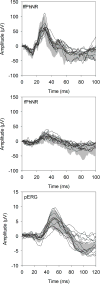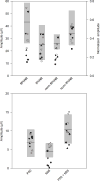Electroretinography in idiopathic intracranial hypertension: comparison of the pattern ERG and the photopic negative response
- PMID: 29139045
- PMCID: PMC5812802
- DOI: 10.1007/s10633-017-9620-z
Electroretinography in idiopathic intracranial hypertension: comparison of the pattern ERG and the photopic negative response
Abstract
Purpose: To evaluate the relationship between electrophysiological measures of retinal ganglion cell (RGC) function in patients who have idiopathic intracranial hypertension (IIH).
Methods: The pattern electroretinogram (pERG) and photopic negative response (PhNR) were recorded from 11 IIH patients and 11 age-similar controls. The pERG was elicited by a contrast-reversing checkerboard. The PhNR, a slow negative component following the flash ERG b-wave, was recorded in response to a long-wavelength flash presented against a short-wavelength adapting field. The PhNR was elicited using full-field (ffPhNR) and focal macular (fPhNR) stimuli. Additionally, Humphrey visual field mean deviation (HVF MD) was measured and ganglion cell complex volume (GCCV) was obtained by optical coherence tomography.
Results: The ffPhNR, fPhNR, and pERG amplitudes were outside of the normal range in 45, 9, and 45% of IIH patients, respectively. However, only mean ffPhNR amplitude was reduced significantly in the patients compared to controls (p < 0.01). The pERG amplitude correlated significantly with HVF MD and GCCV (both r > 0.65, p < 0.05). There were associations between ffPhNR amplitude and HVF MD (r = 0.58, p = 0.06) and with GCCV (r = 0.52, p = 0.10), but these did not reach statistical significance. fPhNR amplitude was not correlated significantly with HVF MD or GCCV (both r < 0.40, p > 0.20).
Conclusions: Although the fPhNR is generally normal in IIH, other electrophysiological measures of RGC function, the ffPhNR and pERG, are abnormal in some patients. These measures provide complementary information regarding RGC dysfunction in these individuals.
Keywords: Electroretinogram; Idiopathic intracranial hypertension; Pattern electroretinogram; Photopic negative response.
Conflict of interest statement
Figures


Similar articles
-
Ganglion cell loss in early glaucoma, as assessed by photopic negative response, pattern electroretinogram, and spectral-domain optical coherence tomography.Doc Ophthalmol. 2017 Aug;135(1):17-28. doi: 10.1007/s10633-017-9595-9. Epub 2017 May 31. Doc Ophthalmol. 2017. PMID: 28567618
-
The Photopic Negative Response in Idiopathic Intracranial Hypertension.Invest Ophthalmol Vis Sci. 2015 Jun;56(6):3709-14. doi: 10.1167/iovs.15-16586. Invest Ophthalmol Vis Sci. 2015. PMID: 26047172 Free PMC article.
-
Comparison between broadband and monochromatic photopic negative response in full-field electroretinogram in controls and subjects with primary open-angle glaucoma.Doc Ophthalmol. 2019 Feb;138(1):21-33. doi: 10.1007/s10633-018-09668-1. Epub 2019 Jan 12. Doc Ophthalmol. 2019. PMID: 30635745
-
The photopic negative response as a promising diagnostic tool in glaucoma. A review.Klin Oczna. 2012;114(2):138-42. Klin Oczna. 2012. PMID: 23346804 Review.
-
Electroretinography in glaucoma diagnosis.Curr Opin Ophthalmol. 2016 Mar;27(2):118-24. doi: 10.1097/ICU.0000000000000241. Curr Opin Ophthalmol. 2016. PMID: 26720775 Free PMC article. Review.
Cited by
-
The photopic negative response of the Light-adapted 3.0 ERG in clinical settings.Doc Ophthalmol. 2020 Apr;140(2):115-128. doi: 10.1007/s10633-019-09723-5. Epub 2019 Oct 1. Doc Ophthalmol. 2020. PMID: 31571069
-
Exploratory Study of the Association between the Severity of Idiopathic Intracranial Hypertension and Electroretinogram Photopic Negative Response Amplitude Obtained Using a Handheld Device.Life (Basel). 2021 May 13;11(5):437. doi: 10.3390/life11050437. Life (Basel). 2021. PMID: 34068365 Free PMC article.
-
Neurophysiological visual assessment in patients with idiopathic intracranial hypertension: visual evoked potential and multifocal field electroretinography.BMC Neurol. 2023 May 10;23(1):188. doi: 10.1186/s12883-023-03220-8. BMC Neurol. 2023. PMID: 37165341 Free PMC article.
-
Electrophysiological and pupillometric measures of inner retina function in nonproliferative diabetic retinopathy.Doc Ophthalmol. 2019 Oct;139(2):99-111. doi: 10.1007/s10633-019-09699-2. Epub 2019 Apr 23. Doc Ophthalmol. 2019. PMID: 31016437 Free PMC article.
-
The photopic negative response (PhNR): measurement approaches and utility in glaucoma.Int Ophthalmol. 2020 Dec;40(12):3565-3576. doi: 10.1007/s10792-020-01515-0. Epub 2020 Jul 31. Int Ophthalmol. 2020. PMID: 32737731 Free PMC article. Review.
References
-
- Wall M. Idiopathic intracranial hypertension. Neurol Clin. 1991;9(1):73–95. - PubMed
-
- Corbett JJ, Savino PJ, Thompson HS, Kansu T, Schatz NJ, Orr LS, Hopson D. Visual loss in pseudotumor cerebri. Follow-up of 57 patients from five to 41 years and a profile of 14 patients with permanent severe visual loss. Arch Neurol. 1982;39(8):461–474. - PubMed
-
- Orcutt JC, Page NG, Sanders MD. Factors affecting visual loss in benign intracranial hypertension. Ophthalmology. 1984;91(11):1303–1312. - PubMed
-
- Hayreh SS. Pathogenesis of optic disc oedema in raised intracranial pressure. Trans Ophthalmol Soc U K. 1976;96(3):404–407. - PubMed
Publication types
MeSH terms
Grants and funding
LinkOut - more resources
Full Text Sources
Other Literature Sources

